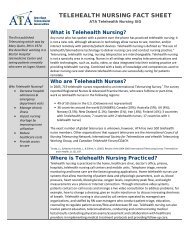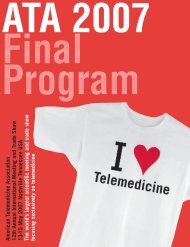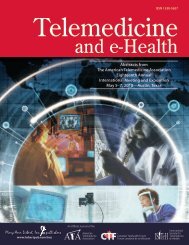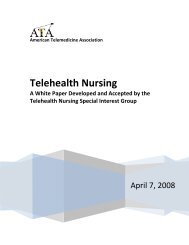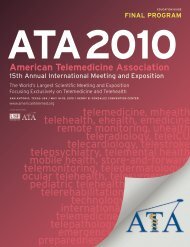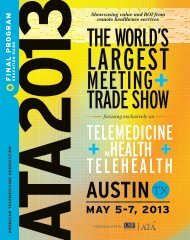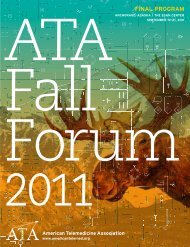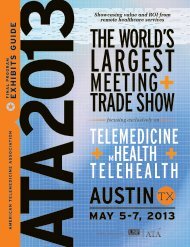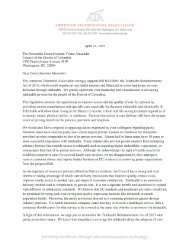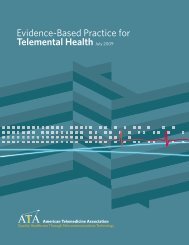Operations Manual for ATA Member Groups
Operations Manual for ATA Member Groups - American ...
Operations Manual for ATA Member Groups - American ...
You also want an ePaper? Increase the reach of your titles
YUMPU automatically turns print PDFs into web optimized ePapers that Google loves.
<strong>Operations</strong> <strong>Manual</strong> <strong>for</strong> <strong>ATA</strong> <strong>Member</strong> <strong>Groups</strong>(July 2011)There are several kinds of ongoing member groups within <strong>ATA</strong>:• Special Interest <strong>Groups</strong> (SIGs) provide <strong>ATA</strong> members with an opportunity to (1) share knowledge,(2) promote and support telemedicine applications within a specialty area (3) provide guidance andin<strong>for</strong>mation to the <strong>ATA</strong> membership under the authority of <strong>ATA</strong>. <strong>ATA</strong> SIG members activelycommunicate, meet regularly, sponsor various activities during the year and convene at the <strong>ATA</strong>Annual Meeting.• Chapters are similar to SIGs but are organized around geographic areas allowing members within aregion to communicate and share in<strong>for</strong>mation. Chapters may encompass a state or aninternational region.• Discussion <strong>Groups</strong> provide a <strong>for</strong>um <strong>for</strong> <strong>ATA</strong> members with similar interests to communicate andmeet with each other during the year and meet at the <strong>ATA</strong> Annual Meeting.• Councils – represent <strong>ATA</strong>’s Circle members (Industry Council) and Institutions (InstitutionalCouncil).In addition, there are short‐term groups and appointed committees that operate <strong>for</strong> a period of timewith a specific objective. These groups fall outside of this manual. For example, Policy Teams(ATeams) are short‐term member groups that provide strategic in<strong>for</strong>mation and recommendations to<strong>ATA</strong> regarding a priority policy issue.<strong>ATA</strong>’s member groups are an integral part of the Association and have become responsible <strong>for</strong> much ofthe activities and leadership of <strong>ATA</strong>. This manual provides guidance and a framework from which the<strong>Member</strong> <strong>Groups</strong> operate within <strong>ATA</strong>.Official oversight of <strong>ATA</strong>’s member groups is the responsibility of the <strong>ATA</strong> Committee on Committees.The <strong>ATA</strong> President‐Elect chairs the Committee on Committees. <strong>Member</strong>ship in the committee iscomposed of the chairs of the SIGs, Chapters, Discussion <strong>Groups</strong> and Councils.Establishing an <strong>ATA</strong> <strong>Member</strong> Group:<strong>ATA</strong> members may petition the <strong>ATA</strong> President to <strong>for</strong>m a new SIG, Chapter, or Discussion Group. Thepetition to establish a new <strong>Member</strong> Group must include a statement of purpose, justification <strong>for</strong><strong>for</strong>mation detailing plans and proposed activities, and a minimum of 30 signatures <strong>for</strong> a SIG or Chapteror 15 signatures <strong>for</strong> a Discussion Group from current <strong>ATA</strong> members who pledge to participate andsupport the group’s activities. The purpose of the petition is to verify that the group has an establishedcore of <strong>ATA</strong> members that are interested in its <strong>for</strong>mation and are willing to actively participate in the1
group on an ongoing basis. The petition should also outline the need <strong>for</strong> the group and potential goalsand priorities.New groups will start as a Discussion Group. After one year, Discussion <strong>Groups</strong> demonstrating activeparticipation and regular communications may petition to become a SIG or Chapter.Approval and Moratoriums ‐ The President of the Association, in consultation with the Chair of theCommittee on Committees and the Executive Committee, may authorize the <strong>for</strong>mation of a SIG,Chapter or Discussion Group. Occasionally, <strong>ATA</strong> may place a temporary moratorium on the <strong>for</strong>mationof additional <strong>Member</strong> <strong>Groups</strong> to ensure the Association has adequate resources to support the groups.Initial Leadership ‐ Upon <strong>ATA</strong> approval of a new SIG or Chapter, the organizing Chair, Vice Chair andSecretary will be appointed by the President of the <strong>ATA</strong> and will serve <strong>for</strong> the initial term up to twoyears. The appointment will be made in consultation with the organizing members of the group.Subsequent leadership will be elected online by the group membership in advance of the <strong>ATA</strong> AnnualMeeting. For a Discussion Group, an organizing Chair will be appointed by the President of <strong>ATA</strong> andwill serve <strong>for</strong> two years. Subsequent leadership will be elected online by the group membership inadvance of the <strong>ATA</strong> Annual Meeting.SIG and Chapter <strong>Operations</strong>Leadership Elections – The leadership of a SIG or Chapter consists of a Chair and Vice Chair. It is<strong>for</strong>eseen that the Vice Chair will assume the Chair position after two years. After initial <strong>for</strong>mation,each SIG or Chapter will elect a new Vice Chair of the group every two years. The election will takeplace several months prior to the <strong>ATA</strong> annual meeting (via email). All <strong>ATA</strong> members of the SIG orChapter are eligible to participate and vote. The member group leadership may appoint additionalexecutive committee officers as outlined below.To elect the Vice Chair, each group will <strong>for</strong>m a nominating committee (NC), who will select onecandidate <strong>for</strong> the role of Vice Chair. The NC will be comprised of 4‐5 people including: the ImmediatePast Chair of the member group, the Board of Directors liaison(s), a member of the SIG or Chapter whois selected by the SIG/Chapter chair and <strong>ATA</strong> staff. The committee will meet via teleconference todiscuss and decide on the Vice Chair candidate <strong>for</strong> the election/ballot. A member of the NC willcontact the candidate of his/her nomination and will collect the candidate’s biography. <strong>ATA</strong> staff willdistribute the ballot to the group’s list serve, including the biography of the individual and votinginstructions. <strong>Member</strong>s of the group may vote <strong>for</strong> the NC’s candidate or “write in” the name of anothercandidate, and <strong>ATA</strong> staff will track the votes of each group. The voting period <strong>for</strong> each group will last 2weeks. After the voting period has closed, <strong>ATA</strong> staff will announce the winner of the election via thelist serve. The term limit <strong>for</strong> Chair is limited to four years (two successive two‐year terms).Executive Committee – Each SIG or Chapter may establish an executive committee. The executivecommittee shall consist of the elected leaders of the group (Chair and Vice Chair). It may also include aSecretary and 3‐5 other members. The maximum number of people on an executive committee is 8.The other members of the Executive Committee should include a cross‐section of representatives fromvarious interests and segments of the group’s membership. These may include different types ofproviders, industry representation, academia, governmental or consumer areas. Appointment or2
emoval of members of the executive committee is the responsibility of the elected Chair inconsultation with and with the approval of <strong>ATA</strong>. <strong>Member</strong>s of the executive committee normally shallserve <strong>for</strong> two years but no more than four years. Executive committee members typically assume theirroles at the Annual Conference, although under special circumstances, a new executive committeemember may join the committee at other times.Other Committees – Any other committee or organized subgroup may be established with the priorapproval of <strong>ATA</strong>.Establishing Priorities and Goals ‐ Each SIG or Chapter is responsible <strong>for</strong> developing an annual set ofgoals and priorities outlining its mission and planned activities <strong>for</strong> the year. SIG and Chapter leaderscollaborate with <strong>ATA</strong> staff to ensure goals are aligned with <strong>ATA</strong> strategic goals and priorities. Fordeveloping annual goals, SIGs and Chapters should solicit input from their membership either throughparticipation at the <strong>ATA</strong> Annual Meeting, during periodic conference calls, or list server dialog. SIGand Chapter leaders are given latitude in developing their work plans which may include such activitiesas developing clinical and technical standards or protocols, developing a database of activities,developing recommendations <strong>for</strong> <strong>ATA</strong> Board action, or sharing in<strong>for</strong>mation. However, SIG and Chapterleaders should include updates to their respective member group web pages as part of the work plan.Priorities and goals which include timelines and names of persons who will be responsible <strong>for</strong>completing each goal should be entered on <strong>ATA</strong>’s standard <strong>for</strong>m and <strong>for</strong>warded to the <strong>ATA</strong>headquarters within one month following the annual meeting <strong>for</strong> review by the Chair of theCommittee on Committees and posting on the group’s web page.SIG and Chapter Annual Meeting Responsibilities ‐ Each approved SIG or Chapter will sponsor a Forumduring <strong>ATA</strong>’s Annual Meeting. The group leadership is responsible <strong>for</strong> developing the agenda andprogram content <strong>for</strong> the Forum. The Forum agenda should be submitted to <strong>ATA</strong> headquarters at leastone month prior to the <strong>ATA</strong> Annual Meeting so it can be included in the final meeting in<strong>for</strong>mation.During the Annual Meeting, SIG and Chapter Chairs and Vice Chairs will convene in a leadershipmeeting with <strong>ATA</strong>’s Chair of the Committee on Committees.Progress Reports – Each group is responsible <strong>for</strong> providing 2 additional progress updates and an annualprogress report to <strong>ATA</strong> as follows:1. Progress updates are due in September and December. This report should record the progress ofthe group’s goals, activities, and accomplishments to date.2. An annual progress report due one month prior to the annual meeting. This report shouldsummarize the group’s goals, activities, and accomplishments <strong>for</strong> the year. The annual progressreport will be distributed during the annual meeting and used <strong>for</strong> consideration of the SIG andChapter Achievement Award.Leadership Responsibilities <strong>for</strong> Communications – SIG and Chapter leaders are responsible <strong>for</strong> regularcommunications with their SIG members and with the <strong>ATA</strong> staff though participation in conferencecalls, list server dialog, and in<strong>for</strong>mation sharing. At least one representative from each group shouldparticipate in quarterly leadership conference calls with the <strong>ATA</strong> Chair of the Committee onCommittees. The purpose of such meetings is to discuss the status of activities, share in<strong>for</strong>mationamong leaders of the groups and discuss any issues affecting group operations. SIG and Chapter3
leaders are also responsible <strong>for</strong> developing and maintaining any meeting minutes or summaries thatmay be needed <strong>for</strong> posting on the web pages.SIG and Chapter Achievement Award ‐ The <strong>ATA</strong> SIG and Chapter Achievement Award will be presentedat the <strong>ATA</strong> Annual conference recognizing outstanding achievements or contributions made by one of<strong>ATA</strong>’s SIG’s or Chapters during the previous year. The description of the award and process <strong>for</strong>selecting the award recipient are found in Addendum A.<strong>ATA</strong> Board <strong>Member</strong> Liaisons ‐ Each SIG and Chapter will have an <strong>ATA</strong> Board of Directors member thatwill serve as a liaison to the Board. Liaisons will serve as a resource to assist with any issues,communicate with SIG or Chapter leaders, and provide the Board of Directors with feedback on howthe group is doing.Discussion Group <strong>Operations</strong>Discussion <strong>Groups</strong> are authorized <strong>for</strong> two years, after which they will be reviewed and, based on thelevel of participation, may be renewed <strong>for</strong> an additional period. Each group will have a list server <strong>for</strong>ongoing dialog among the members. The Discussion Group convenes in person at the <strong>ATA</strong> AnnualMeeting and the group also has a separate page describing the group on the <strong>ATA</strong> web site. The Chairof the Discussion Group will be responsible <strong>for</strong> guiding the group’s discussions and any ongoingcommunications with <strong>ATA</strong> staff. Discussion <strong>Groups</strong> may petition <strong>ATA</strong> to be changed to a SpecialInterest Group or Chapter after one year.<strong>ATA</strong> Oversight of <strong>Member</strong> <strong>Groups</strong>SIG and Chapter Review and Evaluation ‐ SIGs and Chapters are authorized <strong>for</strong> two years.Subsequently, these groups and their associated leaders are subject to a bi‐annual review and approvalby the Chair of the Committee on Committees in consultation with the <strong>ATA</strong> President. The review willbe based upon reports submitted by the SIG or Chapter over the past two years as well as dialog withthe <strong>Member</strong> Group leaders. Renewal of each SIG and Chapter is based on the level of participation inactivities that support <strong>ATA</strong>’s mission and goals and the achievement of the group’s stated goals. Thegroup must also demonstrate regular communications with its members, <strong>ATA</strong> staff and the Chair of theCommittee on Committees and maintain updated web pages.Result of SIG or Chapter Reviews ‐ In the event a SIG or Chapter or leader of a group receives anunsatisfactory review, a subsequent review will take place every six months <strong>for</strong> a one year period. Ifimprovements are not made by the group or the leader, the Chair of the Committee on Committeesand the President will determine a course of action to include: (1) the group <strong>for</strong>mat is changed to aDiscussion Group, (2) the group is suspended (3) the group is retired or (4) the Chair is asked to stepaside. If a <strong>Member</strong> Group is found deficient in membership, to have received unsatisfactory reviews asoutlined above, or to have conducted its business in a manner as shall be considered detrimental tothe interests of <strong>ATA</strong>, the Chair of the Committee on Committees and the President have the power tosuspend the <strong>Member</strong> Group. A SIG or Chapter may be reviewed on an ad‐hoc basis as required.<strong>Member</strong> Group Support <strong>for</strong> <strong>ATA</strong>4
<strong>ATA</strong>’s member groups are expected to promote the Association and encourage broader participationand membership in <strong>ATA</strong>. Such activities may include:• discussions with leaders of associated professional societies and organizations about <strong>ATA</strong> andtelemedicine;• mailings or emails sent to prospective members; and/or• participation at a related professional meeting either through sponsoring a booth, distributingliterature or holding a group <strong>for</strong>um.<strong>Member</strong> Group Restricted Activities<strong>ATA</strong> <strong>Member</strong> <strong>Groups</strong> are authorized and maintained under the legal and organizational framework of<strong>ATA</strong>, which provides authorization, financial and staff support. <strong>Member</strong> groups may recommendpolicy and actions of the Association <strong>for</strong> approval by <strong>ATA</strong> leadership. However, <strong>Member</strong> <strong>Groups</strong> arenot authorized to raise money, spend funds, make legal commitments, or to speak as a group with anyoutside bodies without prior approval of the <strong>ATA</strong> leadership. Legislative and regulatory activity of<strong>ATA</strong>’s member groups must be coordinated with the policy committee and staff and <strong>ATA</strong> review andapproval are necessary be<strong>for</strong>e any <strong>Member</strong> Group draft policy positions can go <strong>for</strong>ward.<strong>ATA</strong> approval is required prior to any <strong>Member</strong> Group publicizing, advertising or marketing a product orpolicy statement to the membership or public. Such issues as copyright, coordination with <strong>ATA</strong> policypositions and finance issues should be addressed prior to the release.Standards and GuidelinesThe <strong>ATA</strong> Board of Directors, working through the Standards and Guidelines Committee, establishesoverall positions on guidelines and standards development within the <strong>Member</strong> <strong>Groups</strong>. <strong>Member</strong><strong>Groups</strong> must follow the guidelines set <strong>for</strong>th in the <strong>ATA</strong> document, Policy and Guidance <strong>for</strong> <strong>ATA</strong>Standards and Guidelines and Quality Assurance Initiatives.Conflicts of Interest and Code of EthicsThe leaders of <strong>ATA</strong>’s SIGs and Chapters are placed in a position of authority within the Association.There<strong>for</strong>e, they are subject to the Association’s Conflict of Interest Policies.Becoming a leader of the <strong>ATA</strong> carries with it an obligation to take Association matters seriously and todevote time to consideration of issues facing this Association. Leaders are required to make decisionsbased on what is best <strong>for</strong> the Association, not what may be advantageous to oneself or to ones ownorganization.Association leaders must avoid actual and even apparent conflicts of interest when making decisionsabout what activities/projects/etc are made <strong>for</strong> their respective groups. Leaders are prohibited fromappropriating <strong>for</strong> themselves or their organizations opportunities that are under consideration by, orbeing carried on by, the Association.5
Leaders must also disclose to the <strong>ATA</strong> headquarters their involvement in any business activities thatmay conflict with, or compete with, any business interests of <strong>ATA</strong>. Leaders having a personal orbusiness interest in a matter under consideration by the <strong>ATA</strong> must disclose that interest. Where actualor potential conflicts of interest are determined the leader must recuse him or herself from theassociated activity or from the leadership position.<strong>Member</strong>ship in <strong>Member</strong> <strong>Groups</strong><strong>Member</strong>ship in SIGs, Chapters and Discussion <strong>Groups</strong> is open to all <strong>ATA</strong> members. No restrictions willbe placed on membership except that the individual must be a current member of <strong>ATA</strong>. <strong>ATA</strong> willprovide its members with a variety of mechanisms in which they may join or be removed from a group.<strong>ATA</strong> maintains a membership list of each group. The membership list is available to the groupleadership but cannot be used in any <strong>for</strong>m without prior <strong>ATA</strong> permission. No commercial uses can bemade of these membership lists.<strong>ATA</strong> Support <strong>for</strong> <strong>Member</strong> <strong>Groups</strong><strong>ATA</strong>’s <strong>Member</strong> <strong>Groups</strong> are designed to be membership‐focused and membership‐driven organizations.<strong>ATA</strong> support <strong>for</strong> the groups includes providing a web page within the overall <strong>ATA</strong> web site, list server,conference calls, and meeting rooms and times at the annual meeting. <strong>ATA</strong> staff will coordinate thegroup’s use of these Association resources.I. Web SiteEach SIG, Chapter, or DG will have a section of the <strong>ATA</strong> web site devoted to the group. <strong>Member</strong> Groupleaders are responsible <strong>for</strong> reviewing and updating these web pages. The group leadership andmembers have the right to determine the in<strong>for</strong>mation kept on their site. In<strong>for</strong>mation to be postedshould be sent in electronic <strong>for</strong>m to <strong>ATA</strong> headquarters. It is suggested that in<strong>for</strong>mation on each webpage should include:1. Name of the <strong>Member</strong> Group2. Description of the SIG or ChapterA. State the purpose or mission of the groupB. How telemedicine is used in this areaC. Goals, priorities and activities <strong>for</strong> the yearD. Delineation of working groups or subcommittees (if applicable)E. Purpose and use of list serverF. Illustrative application(s) that might be accompanied with photos3. <strong>Member</strong> Group Contact In<strong>for</strong>mationA. Name, title, organization, address, phone number, fax number, email address of eachofficerB. Working <strong>Groups</strong>4. <strong>Member</strong> Group ProductsA. Guidelines and ProtocolsB. Forms6
C. PublicationsD. Other In<strong>for</strong>mation5. <strong>Member</strong> Group MeetingsA. SummariesB. Presentations6. Standards, Guidelines and ProtocolsA. A listing and links <strong>for</strong> all relevant technical standards, clinical protocols and otherpertinent in<strong>for</strong>mation that would assist others in the field.7. ResourcesA. LinksB. GlossaryC. PhotosII.ListserversEach <strong>Member</strong> Group shall be provided with an Internet‐based list server <strong>for</strong> communications with itsmembers. The list server will reside at and be maintained by <strong>ATA</strong>. The list is an open <strong>for</strong>um and noef<strong>for</strong>t will be made by <strong>ATA</strong> to monitor submissions of the list. However, anyone who misuses the list,as determined by <strong>ATA</strong>, may be removed from the list.III.Conference Calls<strong>ATA</strong> provides a conference calling service <strong>for</strong> groups to hold conference calls with its members duringthe year. The service includes a toll free number <strong>for</strong> domestic calls. Scheduling calls should becoordinated through <strong>ATA</strong> staff.AmendmentsThis manual may occasionally be amended by <strong>ATA</strong>. The newest version of the manual will be postedon the <strong>ATA</strong> web site in the <strong>Member</strong> Group Section and group leaders will be notified of the latestversion of the manual.7
Addendum A:Annual <strong>ATA</strong> Special Interest Group/Chapter Special Achievement AwardSummary:The Special Interest Group (SIG)/Chapter Achievement Award will be presented annually recognizingoutstanding achievements or contributions made by one of the <strong>ATA</strong>’s SIG’s or Chapters during theprevious year. Consideration <strong>for</strong> this award will be based on a two‐tier peer review process. Theselected SIG or Chapter determined to have contributed the most toward the advancement of the <strong>ATA</strong>Goals in Telemedicine during that year will receive the award and $1,000 which will be presented to itsChair(s) at the Annual Meeting.Award Description:The recipient of this award will receive $1000 from <strong>ATA</strong> funds that may be used <strong>for</strong> SIG or Chaptereducational activities, as recommended by the selected SIG or Chapter Chair(s) and approved by theChair, Committee on Committees. Examples of appropriate uses of this award include an honorarium<strong>for</strong> an invited speaker or <strong>ATA</strong> discounts <strong>for</strong> new or existing hard working members of the associationand its SIG or Chapter. The Chair(s) can not designate him or herself <strong>for</strong> this award or discount.Selection Process:1. The SIG and Chapter Chair(s) submit a self‐nomination(s) <strong>for</strong> a project or activity accomplishedby the group during the year. Nominations are designated as part of the SIG and ChapterProfile report submitted in March preceding the Annual Meeting.2. The initial selection of three competitive projects will be made by the Chair, Committee onCommittees and <strong>ATA</strong> Staff.3. The Chair(s) of the top three finalist projects (selected during the initial review) will be invitedto present a brief summary of their project and its positive impact to the other SIG/ChapterChairs during the scheduled Spring/March SIG & Chapter Leadership Conference Call.4. After that conference call the SIG and Chapter Chairs will vote by email <strong>for</strong> his or her preferredproject. (Each group may cast up to two votes.)5. The SIG or Chapter project or activity that receives the majority votes will be the designatedwinner. In the event there is a tie, the Chair, Committee on Committees, will cast a tie breakingvote representing the <strong>ATA</strong>.6. The award will be announced and presented at the Annual Meeting.8



